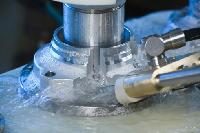ECM Process Deburrs Injection System Components

Deburring may not be a core process in machining, but it is still considered a necessary evil. Although other machining operations have been optimally coordinated, deburring is still not included in the process stream from the start, but EMAG introduces this capability with its Electro-Chemical Machining (ECM) process.
Workpieces with complex contours feature sectors that are note simple to machine because they are difficult to access. Undercuts, pockets and internal, overlapping bores present no major challenges to mechanical machining operations, but this can change when these sectors require deburring. The mechanical, thermal and waterjet-based technologies used up to now cannot guarantee intended output rates, economic viability and repeatability. Medium size and large batch production specifically require high component quality. Internal burrs and lugs can seriously affect this component function. When burrs are removed using standard machining processes, a secondary or "turned down" burr can form and leave further finishing to be needed.
ECM-unlike spark erosion-is a gentle, electro-chemical metal removal process that does not involve spark formations. An electrode is connected to a DC or pulse source to act as a cathode while the workpiece represents the other electrode and is poled as an anode. The charge in the electrode gap between cathode and anode flows in a watery electrolyte solution (sodium nitrate or sodium chlorite, for example) and dissolves metal ions on the workpiece.
The material thus removed can later be filtered out from the electrolyte solution as metal hydroxide. The contour of the cathode is made to fit the machining requirement. This ensures that deburring, without causing mechanical or thermal stresses, takes place only at the point of the workpiece where it is necessary to remove material. This is where the main advantage of the process lies. This pinpoint machining process allows for the most delicate components to be deburred with high accuracy and repeatability.
It is important to define the machining direction from the start when deciding on the machining layout and the sequence of operations. If this is done, burrs can later be removed precisely and economically. The big challenge of the past was that deburring occurred at the end of the machining process. Using ECM, the whole machining process, including the interlinking of machines, will be performed from the start.
ECM is economically viable because as cycle times can be reduced and output rates increased in line with the number of components that can be accommodated in a single fixture, cycle times per component can be set at below 10 seconds.
EMAG's scalable power electronics allow for individual cathodes in a group of workpieces to be monitored separately for quality control. This ensures that the size of the charge in the solution and the volume of metal removed by each cathode can be monitored. ECM is wear resistant, precise and contactless. ECM is enhanced by the PECM process. The P indicates precision that is achieved with a pulsed current, an oscillating cathode and pulse-packets. Quality depends on an efficient pulsed current source and a rigid machine. The ECM and PECM processes are used in the automotive industry, aerospace and the medical equipment industries.





